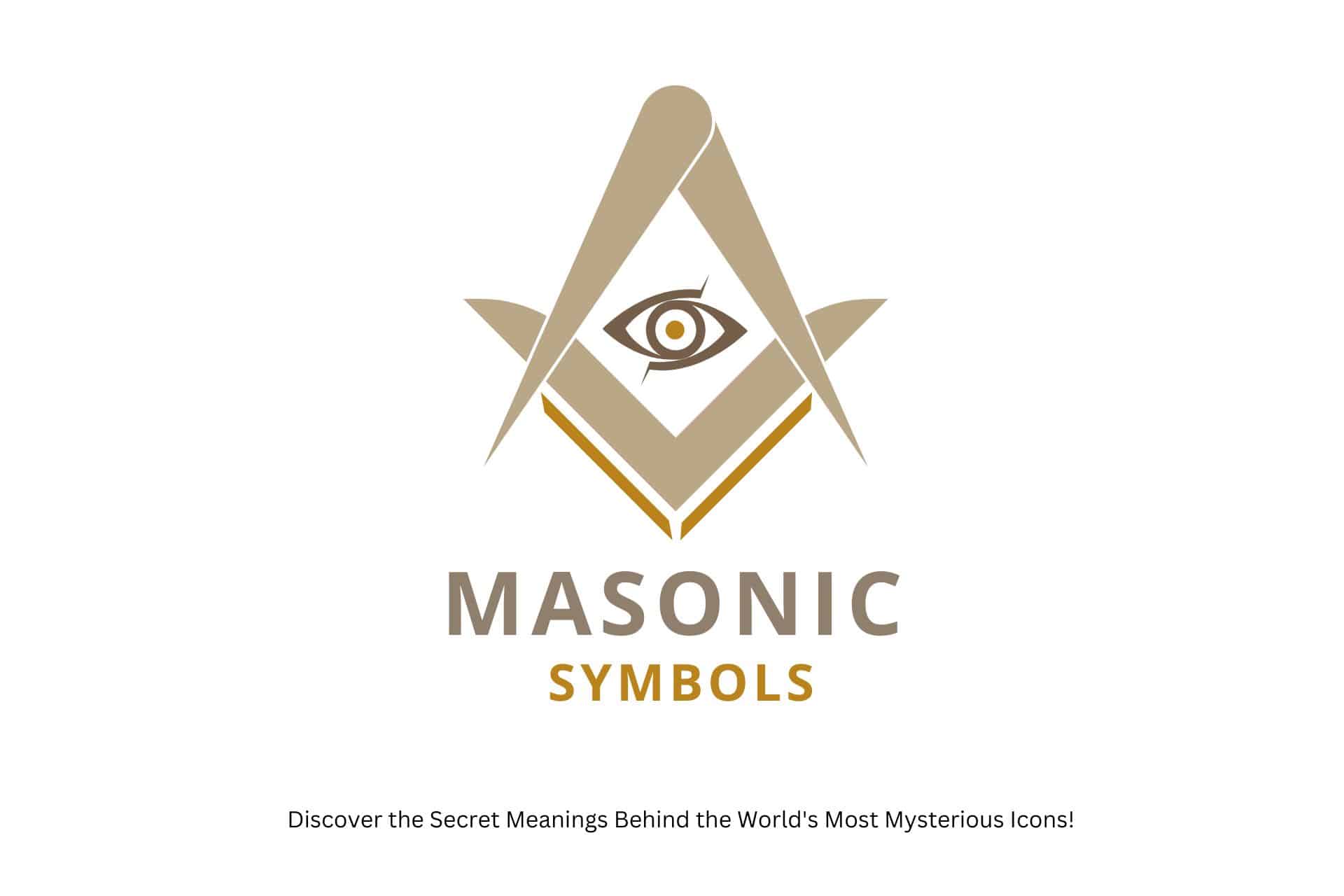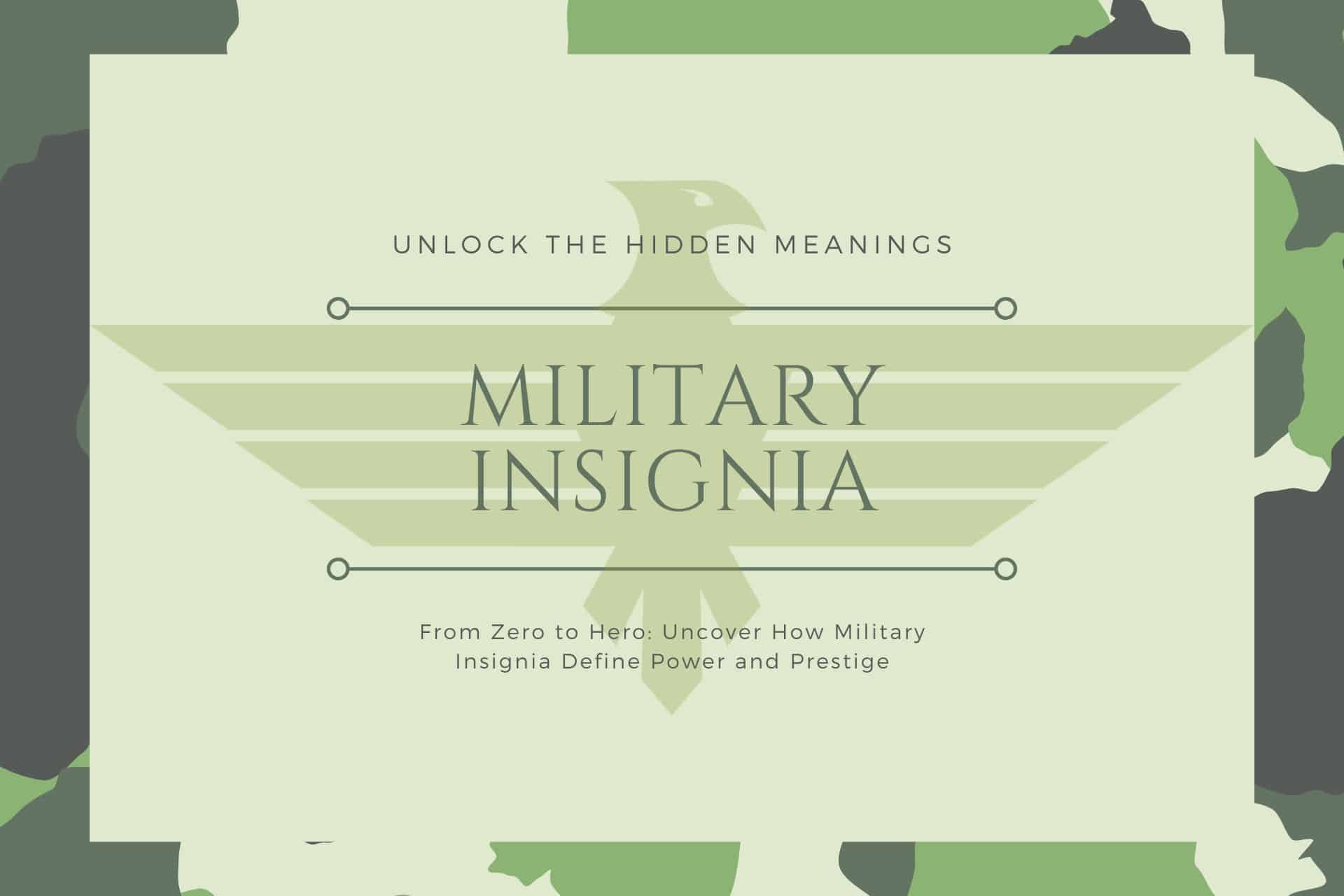Unlocking the Global Language of Money!
Are you puzzled by the proliferation of currency symbols in global finance? Have you ever wondered about the history and significance of these complex computer symbols?
Well, your search ends here. This comprehensive guide offers an insightful journey into the fascinating world of currency symbols. From the ubiquitous dollar sign to the dignified British pound, each has a unique tale etched in history and symbolism.
This guide will help you understand their global variations, enhancing your financial communications and decisions.
With this knowledge, you’ll confidently navigate international transactions, appreciating the culture and economic strength each symbol represents.
So, don’t wait. Continue reading to embark on this fascinating journey. Rest assured, you’re in the right place to demystify the world of currency symbols.
Let’s get started!
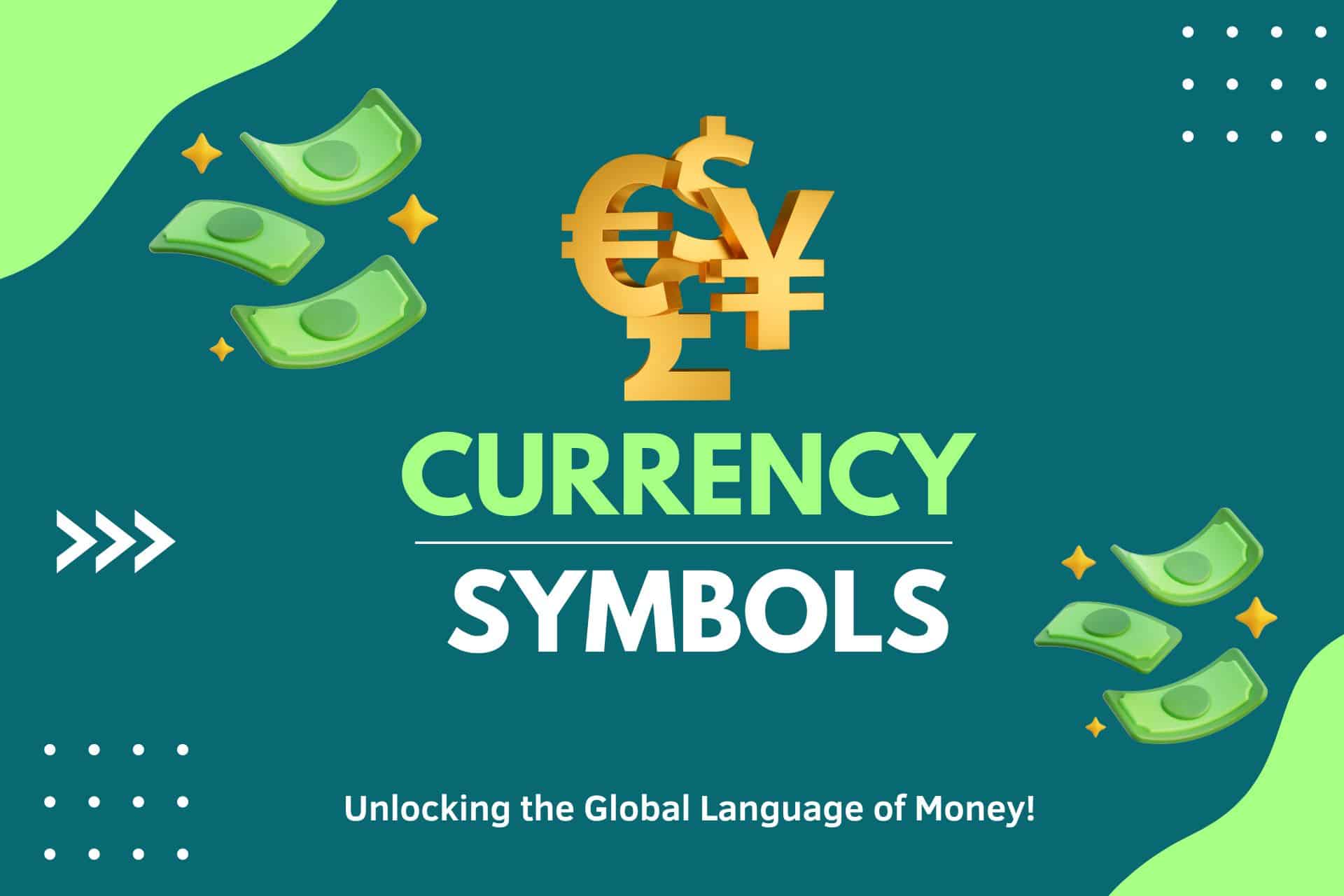
Here’s What You Will Find

Key Takeaways
Currency Symbols
Understanding Currency Symbols: Currency symbols act as universal identifiers for different global currencies, simplifying financial transactions and enhancing comprehension of international markets.
Significance of Correct Usage: Using currency symbols ensures clear financial communication and documentation and avoids confusion in transactions and pricing.
Symbolism in Currency Symbols: Each currency symbol embodies the culture, history, and values of its nation of origin. These symbols often take inspiration from Latin letters or native scripts.
Role of ISO and Central Banks: The International Organization for Standardization (ISO) and central banks have a significant role in standardizing and governing the design and dissemination of currency symbols.
What are Currency Symbols?
Often, you come across different signs and symbols representing various currencies, known as currency symbols.
But what are they? They’re the gateways to understanding and engaging with the world’s markets.
A currency symbol is a graphical symbol used as a shorthand representation of a currency’s name, especially in terms of amounts of money.
Unlike currency names, which can be longer and may vary by language (e.g., “dollar,” “euro,” “yen”), currency symbols are concise and typically consist of a single character or a few characters.
Did You Know?
Currency symbols serve the practical purpose of identifying the currency in financial transactions and economic contexts, making it easier to distinguish between different currencies. Common examples include the dollar sign ($), the euro sign (€), the British pound sign (£), and the Japanese yen sign (¥).
Each symbol has its unique design and is recognized internationally, although not all currencies have a widely used symbol.
Ever notice those symbols next to the numbers on a price tag or a restaurant menu? They’re currency symbols. They’re shorthand, a quick way to express the type of money involved in a transaction. You’ll see them in financial publications, news reports, and your bank account.
Just like the freedom you crave, currency symbols are everywhere. They’re in your pockets, screens, and travel, trade, and investment dreams. Understanding them is critical to opening a world of possibilities. You’re not confined to your country’s currency; you can deal in dollars, euros, yen, or any other currency you choose.
Understanding Currency Symbols
Understanding these symbols isn’t just about recognizing that $ means a dollar or £ stands for pound. It’s about grasping the story behind each symbol.
Every currency symbol is an ambassador of its country’s economic strength and stability. For instance, the mighty $ symbolizes the robust U.S. economy. The €, conversely, represents the unity and cooperation of the European Union economies.

When you understand currency symbols, you’re not just looking at strange signs. You’re peering into the world’s financial dynamics. This knowledge allows you to navigate global markets and make informed decisions. Whether you’re planning a trip abroad, doing international business, or investing in foreign stocks, a clear understanding of currency symbols is necessary.
Don’t be intimidated. It’s not about memorizing every symbol out there but understanding their significance. Once you grasp this, you’ll see the world through a financially savvy lens. Get ready to explore the fascinating world of currency symbols!
Categories of Currency Symbols
Currency symbols serve as shorthand for monetary units around the world. Each symbol is uniquely tailored to represent the economic identity of a country or region.
Types of Currency Symbols
Here’s an overview of various currency symbols grouped by their geographical and economic relevance:
Major Global Currencies
- US Dollar ($): The most widely recognized currency symbol the United States uses.
- Euro (€): The official currency of the Eurozone, representing many European Union countries.
- British Pound Sterling (£): The currency of the United Kingdom, symbolizing its rich economic history.
- Japanese Yen (¥): Japan’s currency symbol, reflecting its significant role in the global economy.
- Chinese Yuan (¥ or 元): This represents China’s currency, which is interchangeable with the symbol for Yen due to shared origins.
European Currencies
- Swiss Franc (CHF): Switzerland’s currency, known for its stability.
- Russian Ruble (₽): The currency symbol for Russia, incorporating the Cyrillic letter ‘R’.
Asian Currencies
- Indian Rupee (₹): India’s currency, with a symbol that combines the Devanagari letter “र” and the Latin letter “R”.
- South Korean Won (₩): This symbol for South Korea’s currency derives from the Korean word “round”.
- Thai Baht (฿): Thailand’s currency, symbolized by a letter from the Thai alphabet.
Middle Eastern Currencies
- Saudi Riyal (﷼): The currency of Saudi Arabia, often seen with a sword symbol.
- Israeli New Shekel (₪): Israel’s currency, combining the first letters of the words “shekel” and “new” in Hebrew.
African Currencies
- South African Rand (R): The currency of South Africa, symbolizing the Witwatersrand gold fields.
- Nigerian Naira (₦): Nigeria’s currency, indicated by an ‘N’ with two horizontal strikethroughs.
North and Central American Currencies
- Canadian Dollar (C$ or CAD): Distinct for Canada, often with a ‘C’ to differentiate from other dollars.
- Mexican Peso ($ or MXN): Mexico’s currency, sometimes distinguished by “MX” to avoid confusion with the US Dollar.
South American Currencies
- Brazilian Real (R$): The symbol for Brazil’s currency, with an ‘R’ for Real and a dollar sign.
- Argentine Peso ($): Argentina’s currency is often identified with an “A” to differentiate it from other peso currencies
Oceania Currencies:
- Australian Dollar (A$ or AUD): Australia’s currency, with an ‘A’ to distinguish it from other dollar denominations.
- New Zealand Dollar (NZ$): This is the symbol for New Zealand’s currency, prefixed with ‘NZ.’
Cryptocurrencies
- Bitcoin (₿): The symbol for Bitcoin, the first decentralized digital currency.
- Ethereum (Ξ): Representing Ethereum, a cryptocurrency known for its smart contract functionality.
Historical Currency Symbols
- Spanish Peseta (₧): The former currency of Spain, now replaced by the Euro.
- French Franc (₣): France’s old currency symbol, also replaced by the Euro.
Special Territorial Currencies
- Hong Kong Dollar (HK$): The currency of Hong Kong is distinct from other dollar-based currencies.
- Caribbean Guilder: Used in some Caribbean nations, symbolizing a local currency adaptation.
Unofficial Currency Symbols
These symbols have gained common usage without formal adoption, such as certain local or community-based currencies. These symbols often have a cultural or historical significance that resonates with the local populace.
If you love freedom, you’ll appreciate that these symbols represent more than money. They’re symbols of independence, each a witness to the unique journey of a nation’s self-definition.
Some symbols, like the Euro, represent unity and shared values, while others, like the Dollar, symbolize individualism and economic power. But remember, every symbol has its own story, waiting to be discovered.
Organizations Regulating Currency Symbols
You’ll find various organizations responsible for regulation and standardization when exploring the world of currency symbols. These organizations guide the design, adoption, and circulation of these symbols, ensuring they reflect the distinct identity of each nation’s currency.
The International Organization for Standardization (ISO) is a key player. It offers the ISO 4217 standard, which assigns unique three-letter codes to world currencies. This system is a beacon of order in the otherwise chaotic financial world. It’s public and designed to simplify international trade and finance. You can access it anytime.
Central banks hold the reins on a national level. They issue and control their country’s currency, including the design and use of its symbol. These institutions, like the U.S. Federal Reserve or the European Central Bank, safeguard the stability and integrity of their currencies.
Numerous organizations work tirelessly to regulate currency symbols, ensuring you can freely engage in cross-border financial activities.
How to Use Currency Symbols
Let’s start by discussing how to use currency symbols in your financial dealings effectively. Understandably, you’re seeking liberty in your transactions, and the appropriate use of these symbols can provide just that.
Using currency symbols correctly ensures clear communication in financial documents, pricing, and economic reports. Here are the steps to use currency symbols effectively:
- Identify the Currency: Determine the currency you are dealing with. Each currency has a unique symbol, such as $ for USD (United States Dollar), € for EUR (Euro), £ for GBP (British Pound Sterling), and ¥ for JPY (Japanese Yen).
- Placement: For most currencies, the symbol is placed before the amount without a space (e.g., $100, £250). The symbol is placed after the amount for a few currencies, sometimes with a space (e.g., 100 kr, 200 zł).
- Decimal and Thousand Separators: Use the correct decimal separator (period or comma) according to the currency’s standard practice. For example, $1,000.50 (one thousand dollars and fifty cents) in the U.S. is equivalent to €1.000,50 (one thousand euros and fifty cents) in many Eurozone countries. For large numbers, use the appropriate thousand separator (comma or period) to enhance readability.
- Currency Code: In international or multicultural contexts where multiple currencies might be involved, use the currency code (ISO 4217) and the symbol for clarity. For example, US$50 to specify U.S. dollars when other dollar currencies are also being discussed.
- Avoiding Confusion: When dealing with currencies that use the same symbol but have different values, such as the dollar or peso, provide context to avoid confusion. This can be done by adding the country abbreviation before the symbol or using the currency code.
- Consistency: Use currency symbols consistently throughout a document or series of communications to avoid potential misunderstandings.
Following these guidelines will help ensure that your use of currency symbols is clear, professional, and universally understood.
Uses of Currency Symbols
Currency symbols are utilized across various platforms and mediums to signify the currency being discussed or utilized. Here are some common uses:
- Pricing and Financial Documents: Symbols are essential in pricing products or services, and they provide clarity in invoices, receipts, financial statements, and other economic documents.
- Foreign Exchange Markets: In forex trading and international finance, currency symbols allow traders to quickly identify and differentiate between currencies when making transactions.
- Advertising and Marketing: Businesses use currency symbols in promotions and marketing materials to indicate cost or savings, appealing to customers’ economic considerations.
- Digital Platforms: E-commerce websites, digital wallets, and online financial services display currency symbols to facilitate international transactions and help users track their spending in their preferred currency.
- Cultural Significance: Currency symbols sometimes carry cultural significance and are used in artworks, literature, and social commentary to evoke ideas about wealth, economy, and identity.
- Educational Materials: Symbols are used in academic contexts to teach economics, finance, and mathematics, helping students familiarize themselves with global economic systems.
Currency symbols streamline communication and transactions in a rapidly globalizing economy by providing a universally understood shorthand for money.
Real-Life Examples
To truly grasp the importance of currency symbols, consider a few real-life scenarios where they come into play. Imagine you’re traveling internationally.
You’re in a bustling market and spot a handmade scarf perfect for your mom. The price tag reads ‘¥2000’. If you didn’t recognize ‘¥’ as the symbol for yen, you might panic, thinking the scarf costs a fortune. Knowing currency symbols, you realize it’s roughly equivalent to $18.
Or imagine this: you’re a freelance graphic designer who just landed a client from Europe. They agree to pay you €500 for your work. If you’re unfamiliar with the symbol ‘€,’ you might underestimate your earnings. Understanding that ‘€’ stands for euros, you know you’re getting about $600.
Currency symbols aren’t just squiggles on a price tag or a paycheck; they’re keys that unlock financial freedom. They allow you to make informed decisions, whether bargain-hunting in Tokyo or negotiating a contract in Paris.
Don’t let unfamiliar symbols keep you from your financial goals. Empower yourself with knowledge and take control of your money.
Why are Currency Symbols Important?
Understanding currency symbols is essential because it allows you to confidently navigate the global economy, making informed decisions about purchases, investments, and payments. You’re not just blindly tossing coins into the air; you’re strategically allocating resources, and that’s an exciting prospect.
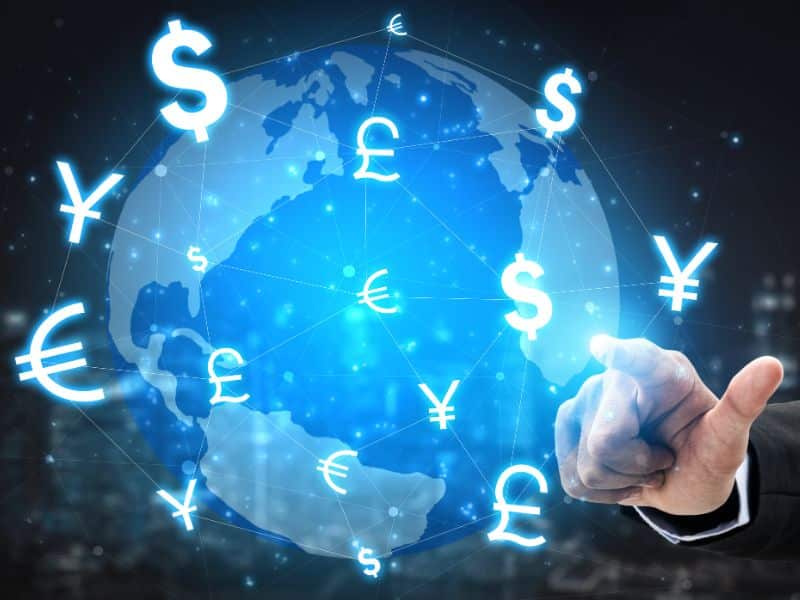
A dollar sign, a euro symbol, or a yen icon aren’t random doodles. They’re powerful tools that open up global marketplaces. With a firm grasp of currency symbols, you can engage with the world on your terms, travel, invest, and live without boundaries, unshackled by ignorance or confusion.
Moreover, understanding currency symbols helps safeguard your financial health. You can avoid unfavorable exchange rates, dodge potential scams, and detect transaction discrepancies. You’re in control, and that’s a liberating feeling.
History of Currency Symbols
Let’s explore the rich tapestry of history behind currency symbols, a journey that will uncover how these influential icons evolved. From ancient civilizations using livestock and grains as a form of trade to the introduction of metal coins and modern paper and digital currencies, these symbols have served as embodiments of economic power and sovereignty.
The story of currency symbols stretches back through time, intertwining with the history of trade, economy, and communication among cultures.
As trade began to evolve from barter systems to using coins and later paper money, the need for a quick, recognizable way to represent these currencies became evident. The history of currency symbols is a fascinating journey that reflects the global shifts in power, culture, and technology.
One of the oldest known currency symbols is the pound sterling (£), which dates back to ancient Roman times when the Libra Pondo (pound weight) was used. The symbol evolved from the letter ‘L’, representing Libra, and it stands as a testament to the enduring legacy of Roman influence on modern financial systems.
Similarly, the dollar sign ($) has a rich history, and several theories about its origin exist. The most widely accepted theory suggests that it stems from the Spanish American peso of the 18th century, which was often abbreviated as ‘PS.’ Over time, the ‘S’ and ‘P’ were superimposed, eventually leading to the ‘$’ symbol we recognize today.
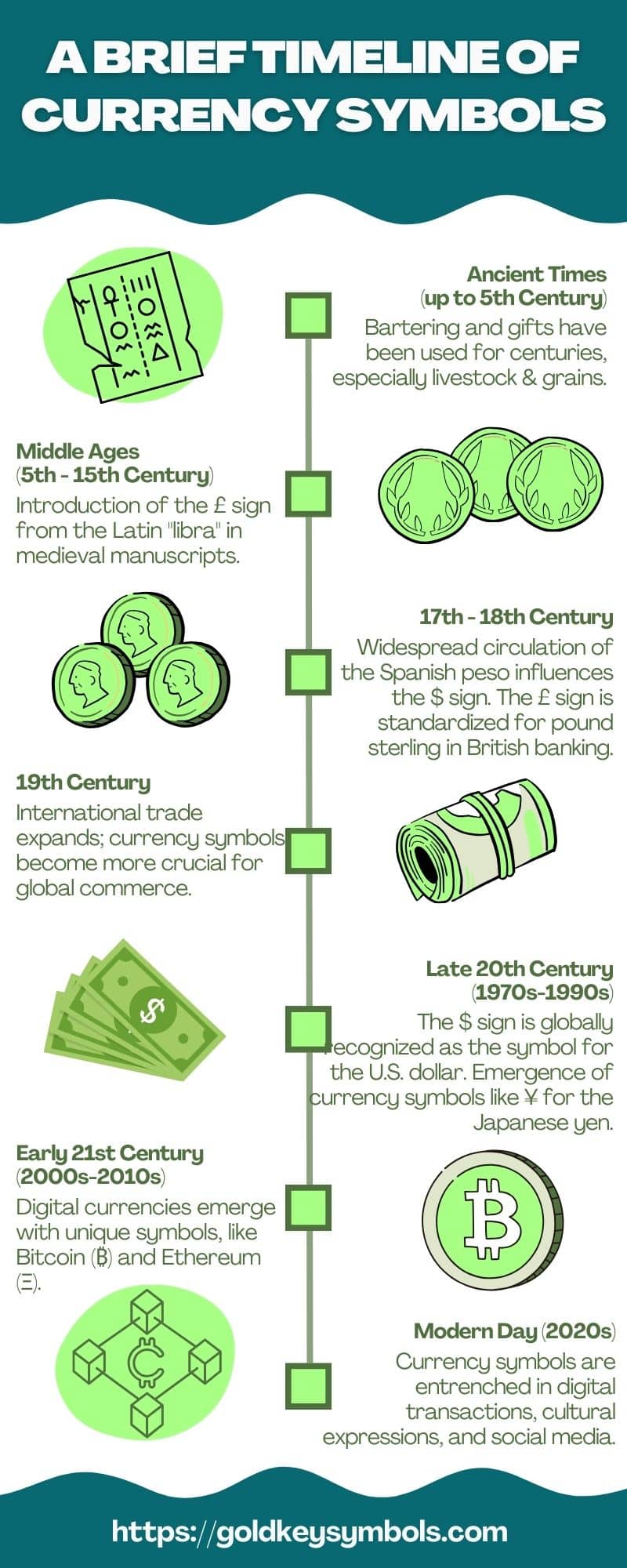
As the world became more interconnected, the need for a universal method of financial communication led to the development of additional currency symbols. The Euro (€), introduced in 1999, symbolizes the unity of the European economy, with its parallel lines representing stability. The design of the Euro symbol itself was the result of a public competition, reflecting the democratic values of the European Union.
The history of currency symbols is not just a reflection of economic evolution but also technological advancement. In the digital age, the representation and usage of these symbols have expanded beyond physical transactions to online banking, digital wallets, and cryptocurrencies.
Symbols like Bitcoin (₿) mark the latest chapter in the long history of currency symbols, representing the shift towards digital currencies and the ongoing innovation in global finance.
Origin
Exploring the origins of currency symbols requires tracing the roots of human civilization’s economic activities. The evolution from trade and barter systems to symbolic currency brought about the need for symbols that could succinctly represent various forms of currency. The origins of these symbols are as diverse as the cultures that created them, often tied to linguistic, historical, and socio-political factors that influenced their design and adoption.
The origin of the pound sterling symbol (£), for example, is deeply rooted in Roman history. It draws from the Latin word “Libra”, which means balance or scales and was also a unit of weight. This connection underscores the importance of weight in determining currency’s value in ancient times.
While the dollar sign ($) is commonly associated with the United States, it originates in the Spanish dollar or pieces of eight, a currency widely used in international trade in the 17th and 18th centuries. This illustrates the global nature of trade and the cross-cultural influences on currency symbols.
The design and adoption of the Euro symbol (€) serve as a modern example of the deliberate creation of a currency symbol intended to represent not just an economic value but also political unity and identity. The selection process involved public input and aimed to create a symbol that was both visually distinct and representative of European heritage, blending historical significance with a forward-looking vision.
The origins of currency symbols also reflect technological and societal changes. For instance, the advent of cryptocurrencies like Bitcoin (₿) introduced a new set of symbols designed for the digital age, emphasizing their decentralized and digital nature. These symbols are not just functional; they symbolize the changing landscape of finance, technology, and society.
The history and origin of currency symbols are a rich tapestry that reflects human societies’ economic, technological, and cultural evolution. From ancient coins to digital currencies, these symbols serve as a universal language for trade and finance, connecting people and markets worldwide.
Frequently Asked Questions
What Are the Cultural Influences on the Design of Currency Symbols?
Cultural influences on currency symbols’ design come from the country’s history, art, and traditions. They’re ways to showcase national identity and values. Think about your nation’s currency symbol; it reflects your cultural heritage, right?
Can a Country Change Its Currency Symbol? What Is the Process?
Sure, a country can change its currency symbol. This is a legal process involving legislation, design, and public consultation. It’s like changing a national flag—there’s a lot of symbolism and history to consider.
Are There Any Mobile Applications for Identifying and Understanding Currency Symbols?
Yes, mobile apps like XE Currency Converter and Currency+ help you identify and understand currency symbols. These apps are handy when you’re dealing with different currencies on the go.
How Are Currency Symbols Incorporated in Financial Software and Systems?
Currency symbols are often integrated directly into transactions in financial software. They’re embedded in the system’s code, ensuring you always know what currency you’re dealing with, making global commerce easier and more efficient.
What Is the Role of Graphic Designers in the Creation of Currency Symbols?
As a graphic designer, you’re instrumental in creating currency symbols. You’ll design symbols that are easily recognized, unique, and adaptable for digital systems. It’s your creativity that turns simple symbols into global financial identifiers.
Last Thoughts
So, you’ve navigated the world of currency symbols! They’re more than just signs; they represent nations’ economic strength. Understanding their categories, history, and importance will better equip you to use them.
Remember, specific organizations regulate these symbols, ensuring global uniformity. Keep exploring, and you’ll discover how currency symbols are woven into our financial lives. It’s a small detail with a significant impact!
Before You Go
Please feel free to share your knowledge from this article with others. Spreading information can help increase understanding and appreciation for the intricate world of currency symbols.
It’s a fascinating topic; sharing it with others may spark thoughtful conversations and deeper insights.
Let’s continue learning together by passing on this valuable information.
Check Other Currency Symbols
- Major Global Currencies
- European Currencies
- Asian Currencies
- Middle Eastern Currencies
- African Currencies
- North and Central American Currencies
- South American Currencies
- Oceania Currencies
- Cryptocurrencies
- Historical Currency Symbols
- Special Territorial Currencies
- Unofficial Currency Symbols
More on Symbols
History of Symbols: How Ancient Marks Shape Our Modern World!
From Cave Walls to Emojis—A Journey Through Time Have you ever wondered about the history of symbols? Maybe you’ve wondered about their global variations or how they’ve shaped our world. Prepare to have your curiosity …
Check it Out!Tattoos and Their Secret Powers: How Ink Can Change Your Life!
Exploring the Art, Meaning, and Culture of Ink! Are you intrigued by tattoos? Are you curious about the stories they tell and the intricate details they contain? Look no further. You might be wondering about …
Check it Out!Masonic Symbols Unlocked: Discover the Secret Meanings Behind the World’s Most Mysterious Icons!
The Hidden Powers and Ancient Secrets You Never Knew! Are you intrigued by masonic symbols and their profound meanings? Perhaps you’ve seen the square, compasses, or the all-seeing eye and wondered about their significance? Thankfully, …
Check it Out!Military Insignia: Unlock the Hidden Meanings Behind These Powerful Symbols
From Zero to Hero: Uncover How Military Insignia Define Power and Prestige Are you curious about the meaning behind military insignia or rank emblems? Have you ever wondered about their significance or history? This comprehensive …
Check it Out!More Symbols



